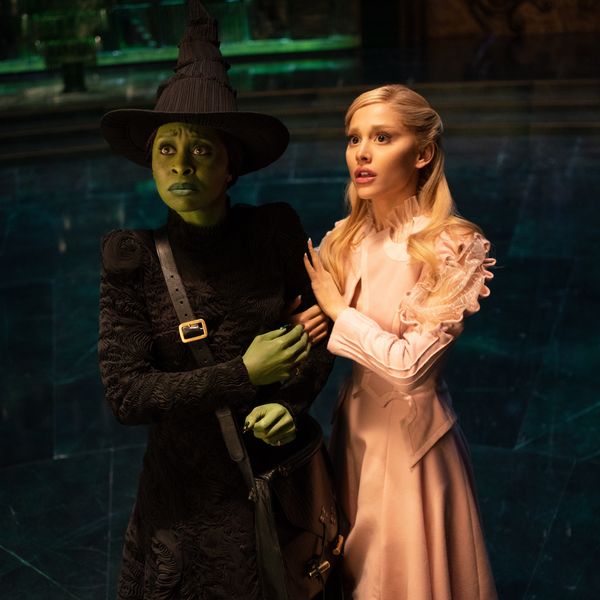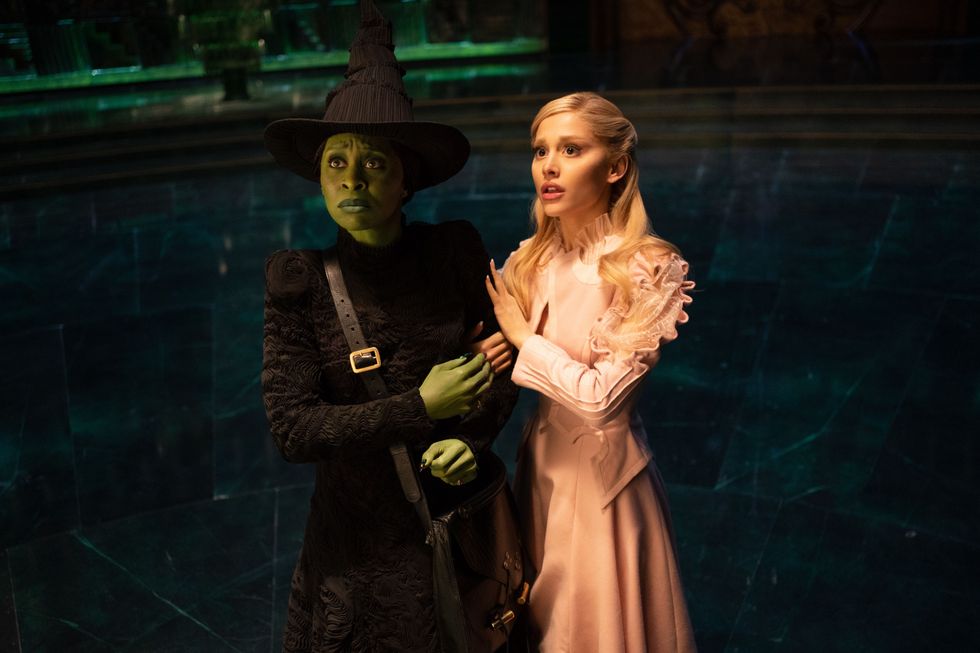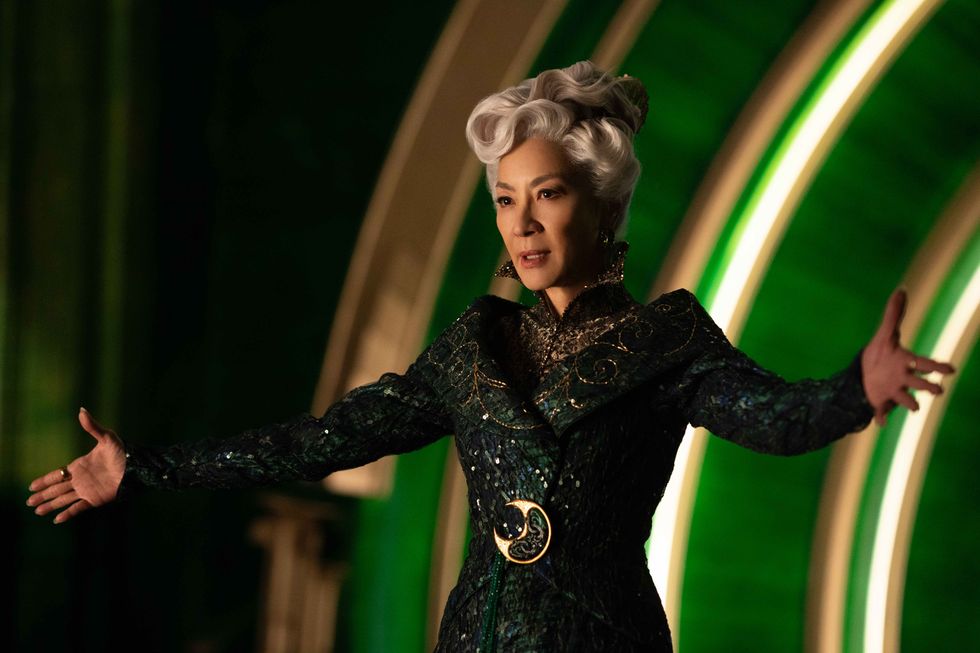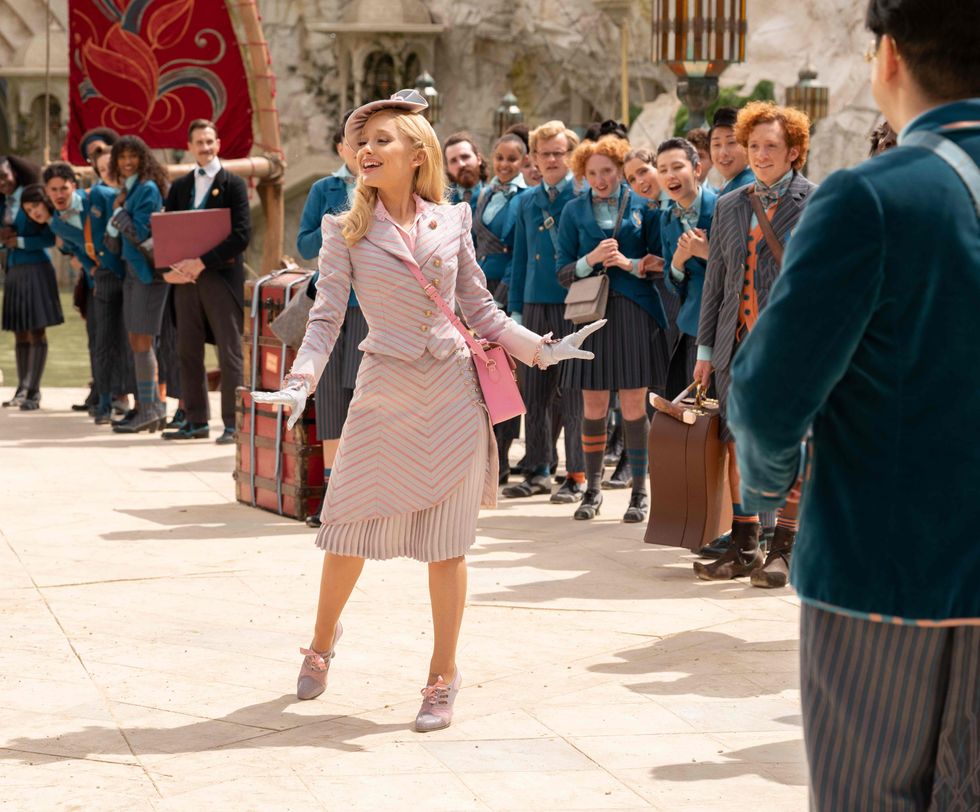
How the Land of Oz's Clothing Came to Life in 'Wicked'
Nov 25, 2024
Good news! Wicked is finally in theaters.
After 21 years running at the Gershwin Theatre in New York City, the Broadway musical has its own film adaptation starring Ariana Grande and Cynthia Erivo. The two portray Glinda the Good Witch and the Wicked Witch of the West, respectively, providing a backstory for the iconic and beloved characters from The Wizard of Oz.
The film's costume designer is Paul Tazewell, who's won a Tony Award for his work on Hamilton, a Primetime Emmy Award for The Wiz Live! and received an Oscar nomination for 2021's West Side Story. For Wicked, Tazewell had several references: Gregory Maguire’s Wicked: The Life and Times of the Wicked Witch of the West (the novel that inspired the plot of Broadway musical), Victor Fleming's 1939 film The Wizard of Oz, the Broadway show itself and nature.
Staying true to much of this material, Tazewell nonetheless created an entirely new fantastical world of his own with the film's costumes. "We want to establish a new point of view for this Oz and how we're telling the story for the film," Tazewell tells PAPER from London over video call before the city's film premiere. "It opened up the floodgates for my creativity, being able to express my own point of view. We wanted to create a world that felt mysterious and delightful and really allowed for this story and the characters to actually exist."
Below, Paul Tazewell tells PAPER all about working with Grande Erivo and the stacked cast and how he made the Land of Oz come to life for a new generation.
Hi Paul! How has all of this been for you?
It's been really great from the very beginning. It's kind of idyllic, the creative team and the cast and where we filmed over in London. As everything is rolled out, it's been full-on, and it was full-on from the moment that I stepped off of the plane right before prep.
When did you get started on the process?
It was about a year before I came over [to London], and that was two years ago in June, so it was quite a long time. It was necessary to design [for] these two films, because we filmed them simultaneously. I was designing in New York, mostly, and then, originally, we thought that we were going to be filming in Atlanta. Then they changed, and we ended up filming in London.
When designing for a fantastical and fictional place like Oz in the world of Wicked, how do you even begin to define what that looks like?
John M. Chu, the director, said to me that we don't want to recreate what was on Broadway. We want to establish a new point of view for this Oz and how we're telling the story for the film. It opened up the floodgates for my creativity, being able to express my own point of view. That was a delight to be able to be given the license to re-envision it. That said, The Wizard of Oz film from 1939 has always been a visual reference for me — the use of color and visual icons like Glinda, Munchkinland, Dorothy, the Wicked Witch of the West. All of that is completely part of what I carry around in general. That's a beloved film.
Knowing Wicked, the Broadway show, and the fan base that it has, I felt like it was important to provide a world that they could engage with, as well. I thought that it was definitely important to be able to pull both elements in. I wasn't interested in copying anything, but I was referencing a lot of the icons of the film, starting with Glinda and the fact that she arrives in the bubble and using pink as a springboard for her color palette.
When you start world-building, which I did in collaboration with Nathan Crowley, the production designer, you have to figure out if you’re going to reference a period and what the rules are and what you have as an environment and how people are dressing themselves. And within this environment, the Land of Oz, are a number of different lands, as well, like Munchkinland and the Emerald City, so all those need to talk together.
What were some of your references outside of existing movies set in Oz and the Broadway musical?
Throughout the two films, I was looking at a lot of nature, finding a reference that could be timeless and also inspire fantasy. And then that was adopted by the other designers as well. For Nathan, he was inspired by Art Nouveau throughout. Many of his forms are very lyrical. For myself, I was dipping into the idea of the Fibonacci spiral. I was seeing it in a lot of the visual references that I was very drawn to. I was looking at [Maurits Cornelis] Escher, and some of those intricate staircases and how those decorative forms were mysterious. We wanted to create a world that felt mysterious and delightful and really allowed for this story and the characters to actually exist.
You enter with a sense of reality, because we've worked very hard to create all of the different elements of this world. In every crack and crevice, you're seeing what this world might possibly be, down to all the minute details for the costumes. I was interested in designing very specifically.

Are there any specific looks that you think really define Elphaba and Glinda at this point in their story?
A beautiful element of this film is that I was able to depict them in so many parts of their lives. We're giving them a back story. We see where they've come from. But then we move through their year at Shiz and beyond.
We see Elphaba as a child with her sister, so that we get to understand that emotional dynamic. We set her up as connected to nature and as the advocate of animals, and because of that, her pinafore and dress feel very organic. It's also black, which sets up the fact that she started wearing black very young. But we had to make sense of that decision. She's in mourning for her mother, and she holds on to that visual partly for protection. She is armoring herself because of the environment that she's in, and also to set her apart. The decisions are real so that we can understand them as an audience. That is the beauty of the film, as well, is that you have this fantastical world, but the emotions and relationships that are within it are very real.
How do you see her character development through her change in clothing?
Elphaba goes from the little girl's dress into that beautiful black coat, and then the dress that's underneath, which is hand felted and has details inspired from mushrooms, tying her or her to nature as a point of reference. And then she goes into a Shiz uniform, which has the same kind of structure and rigidity that her original clothes have. As she finds acceptance within the community of Shiz and for herself, she starts to open up. She starts to loosen. And as she's developing her magic and really taking hold of that, she's going into silhouettes that are more trousers with kilts, and they allow for more agility. It's a modern silhouette that feels more powerful than some of the silhouettes that are based in the turn of the century. It’s a huge creative license, but it has that point of reference because of the dress from the 1939 film of The Wizard of Oz. Everyone is entering into the theater to experience Wicked with some point of reference of what this world is.
Do you have any moments that you look back on that will stay with you forever?
The whole process was really hard to break away from. We're working to tell the story of this fantasy world that has so much heart with a beautiful cast. Craftspeople and tailors and all kinds of artisans have each given their all to the design — all of us engaged to make this the most beautiful movie that it could possibly be. It was just a magical time.
It was also challenging. The days were full-on. The number of questions that I had to answer in a day was mind boggling. All of those things had to be custom made, and they were all custom made at a couture level, so that it resonated as this brand new world to invite everybody into and make it believable. I spent hours and hours in fittings with this amazing cast, with Cynthia, with Ariana, developing relationships with Jonathan Bailey and Michelle [Yeoh] and Jeff [Goldblum]. There was a bond that was created knowing that we all were intent on the same goal in the end.
I remember we were doing our last day of the press shoot, and I happened to be there with Ariana. It was overwhelming and very moving. I broke down a little bit, because we were done, and we were handing it over to everyone else to make the film what it's become. It was a feeling that I had never felt. I wouldn't have fittings with Ariana, with Cynthia anymore. Now it's just a memory, but it was a beautiful time.
Photos courtesy of Giles Keyte/Universal and Paul Tazewell
From Your Site Articles
MORE ON PAPER
Entertainment
Cynthia Erivo in Full Bloom
Photography by David LaChapelle / Story by Joan Summers / Styling by Jason Bolden / Makeup by Joanna Simkim / Nails by Shea Osei
Photography by David LaChapelle / Story by Joan Summers / Styling by Jason Bolden / Makeup by Joanna Simkim / Nails by Shea Osei
01 December
Entertainment
Rami Malek Is Certifiably Unserious
Story by Joan Summers / Photography by Adam Powell
Story by Joan Summers / Photography by Adam Powell
14 November
Music
Janelle Monáe, HalloQueen
Story by Ivan Guzman / Photography by Pol Kurucz/ Styling by Alexandra Mandelkorn/ Hair by Nikki Nelms/ Makeup by Sasha Glasser/ Nails by Juan Alvear/ Set design by Krystall Schott
Story by Ivan Guzman / Photography by Pol Kurucz/ Styling by Alexandra Mandelkorn/ Hair by Nikki Nelms/ Makeup by Sasha Glasser/ Nails by Juan Alvear/ Set design by Krystall Schott
27 October
Music
You Don’t Move Cardi B
Story by Erica Campbell / Photography by Jora Frantzis / Styling by Kollin Carter/ Hair by Tokyo Stylez/ Makeup by Erika LaPearl/ Nails by Coca Nguyen/ Set design by Allegra Peyton
Story by Erica Campbell / Photography by Jora Frantzis / Styling by Kollin Carter/ Hair by Tokyo Stylez/ Makeup by Erika LaPearl/ Nails by Coca Nguyen/ Set design by Allegra Peyton
14 October
Entertainment
Matthew McConaughey Found His Rhythm
Story by Joan Summers / Photography by Greg Swales / Styling by Angelina Cantu / Grooming by Kara Yoshimoto Bua
Story by Joan Summers / Photography by Greg Swales / Styling by Angelina Cantu / Grooming by Kara Yoshimoto Bua
30 September



















